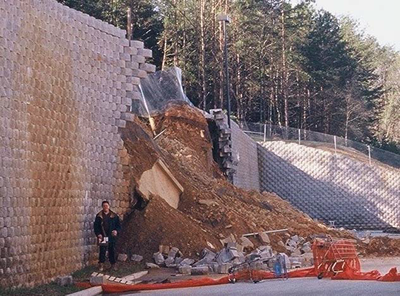
“Koerner’s Korner” returns! Dr. Robert Koerner of the Geosynthetic Institute (GSI) shares updates on and insight from GSI’s work. In this installment, he discusses MSE wall failures and the new GSI webinar series–the first four sessions of which address MSE wall design and performance issues. – Geosynthetica
**
It is generally known that there have been a number of failures of mechanically stabilized earth (MSE) walls reinforced with geosynthetics. In order to properly describe the situation as well as its reasons and solutions, a series of four 90-minute webinars are being offered. Two have been held and two more are scheduled.
- June 12, 2013 – “MSE Wall Failure Data Base” (to be repeated 6/11/14)
- July 10, 2013 – “MSE Wall Back Drainage Design” (to be repeated 7/9/14)
- August 14, 2013 – “MSE Wall Remediation”
- September 11, 2013 – “MSE Wall Inspection”
The June 12 webinar presented the statistics of 171 wall failures and set the stage for the subsequent three webinars in the series. Since GSI has embarked on a project to issue 12 webinars per year (a new session on the 2nd Wednesday of every month), the topic of June 2013’s session will be repeated in June 2014.
The July 10webinar was focused entirely on the design and installation of back drainage behind the reinforced soil zone. Water being the major cause of the failures (60%) makes back drainage almost a necessity.
NEXT WEBINAR

The August 14 webinar, “MSE Wall Remediation,” will cover the following:
The GSI database of failed MSE walls indicates that 44 out of 171 failures with geosynthetic reinforcement were caused by excessive deformation. Of these 44, 25 were remediated before they actually collapsed. This webinar presents methods of mechanical strengthening the deformed walls (using ground anchors, rock bolts or soil nailing) and also the potential of using dewatering methods (using horizontal drains, pumped vertical wells and combined systems).
This webinar then presents details of ten of the remediated walls. All of them were remediated using mechanical strengthening. Within the group were ground anchors (5), soil nails (4) and complete rebuilding (1). The cost of the remediations varied from 1.05 times the original cost to 3.50 times. The rebuild case history was 4.66 times the original cost.
Monitoring of the original or remediated walls will be suggested in the context of standard surveying, lazer/radar/lider methods, slope inclinometers, piezometers and/or continuous deformation gauges. Criteria on allowable wall deformation will conclude the webinar.
We hope you will join us for this webinar and, if interested, go to www.geosynthetic-institute.org/webinar.htm for additional details and registration. You will note that there is a charge since the long-distance telephone charges plus the video platform are quite expensive. Sorry about that!
– Bob Koerner











